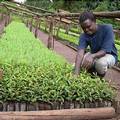 不久之後,烏干達境內的草原上將種滿松樹與非洲原生樹種混合林。由於樹木生長可吸收大氣中的溫室氣體二氧化碳,這項位於烏干達維多利亞湖上游「魯沃霍中央森林保護區」的造林計畫,將可列入京都議定書所認可的碳權抵換額度,創下非洲首例。
不久之後,烏干達境內的草原上將種滿松樹與非洲原生樹種混合林。由於樹木生長可吸收大氣中的溫室氣體二氧化碳,這項位於烏干達維多利亞湖上游「魯沃霍中央森林保護區」的造林計畫,將可列入京都議定書所認可的碳權抵換額度,創下非洲首例。
這項「尼羅河流域再造林計畫」是由烏干達國家林務局結合在地社區所推動,資金來自世界銀行所提供的「生物碳基金」。
世銀行烏干達經理Kundhavi Kadiresan表示:「這對烏干達而言是一個里程碑,特別是這項再造林計畫從籌備到批准階段,充滿諸多困難……我很欣慰這項計畫不僅提供實質的財務資源,還創造了多達700個工作機會給當地居民。」該計畫預計在植樹階段提供500個工作機會,而後續的常務森林管理工作則可提供200個工作機會。
生長快速的加勒比松(Pinus caribaea),雖然不是非洲原生種,但目前正在該地區進行測試,預計藉由「尼羅河流域再造林計畫」的執行,該地區有75%面積將由加勒比松所覆蓋。此外,還預計種植20%的非洲大型樹種Maesopsis eminii,以及5%的非洲李。非洲李是常綠樹種,其樹皮有珍貴的藥用價值。
目前,全世界符合京都議定書「清潔發展機制」(CDM)的造林抵換碳權計畫,全球只有八個,烏干達計畫是其中之一。該計畫中有1/3的土地使用變更,是登記在「生物碳基金」名下,「生物碳基金」經理Ellysar Baroudy表示,「烏干達計畫是第一個透過聯合國清潔發展機制的管道進行註冊的,而且參與雙方都能獲得極大的益處,例如地方社區有了較高的收入,對氣候變遷也有更大的適應能力。」
所謂「生物碳基金」,是運用造林(afforestation)或再造林(reforestation)計畫來購買碳權,這種抵換模式符合京都議定書所制定的「清潔發展機制」。
Pines and a mix of native African trees will soon cover what is now grassland within Uganda's Rwoho Central Forest Reserve, an upper watershed of Lake Victoria.
The growing trees will absorb the greenhouse gas carbon dioxide, CO2, from the atmosphere, and with these plantings, Uganda becomes the first country in Africa to undertake a reforestation project that will count towards emissions reductions under the Kyoto Protocol.
Called the Nile Basin Reforestation Project, the tree planting is being implemented by Uganda's National Forestry Authority in association with local community organizations, using funds provided by the World Bank's BioCarbon Fund.
"This is a milestone for Uganda, especially considering the difficulty associated with bringing reforestation projects to this stage of final approval. I am happy that apart from providing physical financial resources, the project will also generate up to 700 jobs for the local population," said Kundhavi Kadiresan, World Bank country manager for Uganda.
The project will generate about 500 jobs during planting and 200 jobs during ongoing management of the forest.
The project area will be covered with 75 percent with non-native Pinus caribaea, a quick-growing Caribbean pine that has been introduced and tested in the area. In addition, treeplanters will put in 20 percent Maesopsis eminii, a large African forest tree; and five percent Prunus africana, an evergreen with bark that is prized for its medicinal properties.
The Ugandan project is one of only eight reforestation projects worldwide that have been approved to date to count towards emissions reductions under the Kyoto Protocol's Clean Development Mechanism, and only the third land use change project to be registered in the BioCarbon Fund.
"The Uganda project is the first of several projects that are in the United Nations Clean Development Mechanism pipeline for registration, and which can lead to strong co-benefits, including higher incomes for local communities and greater climate resilience," says Ellysar Baroudy, fund manager for the BioCarbon Fund.
The BioCarbon Fund purchases emission reductions from afforestation and reforestation projects under the Clean Development Mechanism of the Kyoto Protocol.
全文及圖片詳見:ENS


